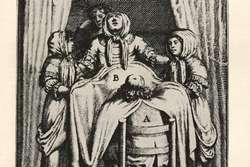The term [obstetrics] arises from the Latin word [obstare] which means "to stand close to" or "to stand in front of". Since a midwife "stands" in front of the patient for child delivery, the word was used in its feminine singular form [obstetrix]. The Latin plural is [obstetrices]; The evolution of the term into modern "obstetrics" is quite clear.
Through the ages the term used for someone who helps deliver a child has changed. Andreas Vesalius used the term [obstetrices nutrices] meaning "nurse midwife". The term "midwife" was used for a long time, being replaced today for the word "obstetrics" and "obstetrician".
Although all female reproductive system care was originally the domain of midwives, through time two distinct specialties have evolved. Gynecology refers to the medical specialty that studies and treats the female reproductive system. Obstetrics, deals with the care of the pregnant patient and delivery of the fetus. Male-widwives in Europe were allowed access to the patient only with the use of a "modesty blanket". This is plate XV from the 1681 book "Korte en Bondige Van Der Voortteeling en Kinderbaren" by Samuel Janson.
As an interesting side note in history, the first male physician to attempt to work as a man-midwife was Dr. Wertt from Hamburg. Dr Wertt decided to disguise himself as a woman to attend patients. When he was discovered, the punishment was "swift and salutary": He was burned at the stake.
Word suggested and edited by: Dr. Sanford S. Osher , MTD Contributor



